I am working on a DICOM viewer project that combines PET and CT.
Progress
Adjust the size of one of the two dicom files to the larger one.
And change the color of one dicom file
And merge the two dicom files
example dicom bitmap1
bitmap2 , newBitmap(change color Red)
The result image I am aiming for
private void button1_Click(object sender, EventArgs e)
{
string ima_path = Environment.GetFolderPath(Environment.SpecialFolder.MyDocuments);
var bitmap1 = dicomImageViewControls[0].DicomElements[0].Bitmap;
var bitmap2 = dicomImageViewControls[1].DicomElements[0].Bitmap;
if( bitmap1.Width<bitmap2.Width)
{
bitmap1 = resizeImage(bitmap1, bitmap2.Width, bitmap2.Height);
bitmap1.Save(ima_path + "\\res.png", ImageFormat.Png);
}
else
{
bitmap2 = resizeImage(bitmap2, bitmap1.Width, bitmap1.Height);
bitmap2.Save(ima_path + "\\res.png", ImageFormat.Png);
}
Color actualColor;
Bitmap newBitmap = new Bitmap(bitmap2.Width, bitmap2.Height);
for (int i = 0; i < bitmap2.Width; i++)
{
for (int j = 0; j < bitmap2.Height; j++)
{
actualColor = bitmap2.GetPixel(i, j);
float a = actualColor.A;
float r = actualColor.R;
newBitmap.SetPixel(i, j, Color.FromArgb((int)a, (int)r, 0, 0));
}
}
var target = new Bitmap(newBitmap.Width, newBitmap.Height, PixelFormat.Format32bppArgb);
var graphics = Graphics.FromImage(target);
graphics.CompositingMode = CompositingMode.SourceOver; // this is the default, but just to be clear
graphics.DrawImage(newBitmap, 0, 0);
graphics.DrawImage(bitmap1, 0, 0);
newBitmap.Save(ima_path + "\\Image2.png", ImageFormat.Png);
}
public static Bitmap resizeImage(Bitmap image, int width, int height)
{
var destinationRect = new Rectangle(0, 0, width, height);
var destinationImage = new Bitmap(width, height);
destinationImage.SetResolution(image.HorizontalResolution, image.VerticalResolution);
using (var graphics = Graphics.FromImage(destinationImage))
{
graphics.CompositingMode = CompositingMode.SourceCopy;
graphics.CompositingQuality = CompositingQuality.HighQuality;
using (var wrapMode = new ImageAttributes())
{
wrapMode.SetWrapMode(WrapMode.TileFlipXY);
graphics.DrawImage(image, destinationRect, 0, 0, image.Width, image.Height, GraphicsUnit.Pixel, wrapMode);
}
}
return destinationImage;
}
target bitmap
It looks like the first picture.
======================================= I found a new algorithm in clear canvas.
baseImageGraphicProvider.ImageGraphic.PixelData.ForEachPixel(
(n, x, y, i) =>
{
// and this is why the base and overlay slices must be unsigned precisely coincident
var patientLocation = baseImageSopProvider.Frame.ImagePlaneHelper.ConvertToPatient(new PointF(x, y));
var overlayCoordinate = overlayImageSopProvider.Frame.ImagePlaneHelper.ConvertToImagePlane(patientLocation);
var baseValue = (ushort) baseImageGraphicProvider.ImageGraphic.PixelData.GetPixel(i);
var overlayValue = overlayImageGraphicProvider.ImageGraphic.PixelData.GetPixel((int) overlayCoordinate.X, (int) overlayCoordinate.Y);
// the fusion operator: output = underlyingGrey*(1-alpha) + overlayingColour*(alpha) (see DICOM 2009 PS 3.4 N.2.4.3)
var compositeColor = ToRgbVectorFromGrey(baseValue)*(1 - opacity) + ToRgbVector(colorMap[overlayValue])*opacity;
pixelData[3*n] = (byte) compositeColor.X;
pixelData[3*n + 1] = (byte) compositeColor.Y;
pixelData[3*n + 2] = (byte) compositeColor.Z;
});
I think this algorithm is
var compositeColor = ToRgbVectorFromGrey(baseValue)*(1 - opacity) + ToRgbVector(colorMap[overlayValue])*opacity;
Get the original pixel rgb from greycolor (1-opactiy) + color palette (red palette in my case) *opacity Returns the value of each pixel.



